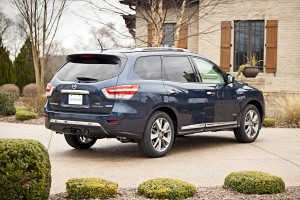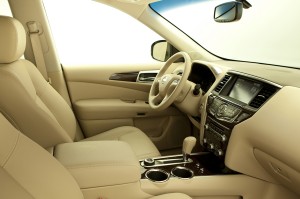 As an environmental journalist who covers the automobile industry, as well as a father of four I’m always eager to learn about product launches of vehicles that utilize three rows of seating as well as eco-friendly technologies.
As an environmental journalist who covers the automobile industry, as well as a father of four I’m always eager to learn about product launches of vehicles that utilize three rows of seating as well as eco-friendly technologies.
In so far as 7-seat hybrids have been concerned, for years the market has all but exclusively been held by the Toyota Highlander. However just as Toyota was preparing to launch it’s 3rd generation Higlander and Highlander Hybrid, the market has become suddenly a bit more crowded.
Nissan and it’s luxury brand Infiniti have each launched hybrid versions of their successful 7 seat crossovers with Nissan recently debuting their Pathfinder Hybrid, while Infiniti has launched it’s QX60 Hybrid. Both vehicles are essentially built and designed on the same platform and utilize the same new hybrid technology that Nissan has developed.
Over the past year and a bit, I had had the chance to review both non-hybrid versions. I reviewed the Infiniti JX35 (now known as the QX60) when it was originally launched in 2012 and I had the chance to review the newly designed Pathfinder last year. I was eager to get behind both new hybrids to see how they compared and recently arranged to drive them both back to back.
 Turning Crossovers into Hybrid Crossovers
Turning Crossovers into Hybrid Crossovers
Attempting to create a hybrid out of an existing 3 row crossover presents itself with certain challenges. Typically when a hybrid is developed, the positioning of the battery – usually behind the rear seats – results in a significant reduction of cargo space in the rear trunk. As 3 row crossovers already are limited somewhat in terms of cargo space when all rows are up and in use, the challenge becomes how to position a battery so as to not further limit what is already there.
In both vehicles the answer was to place a smaller than usual battery directly underneath the 3rd row so that no reduction of cargo room or passenger comfort is sacrificed. The obvious drawback to this is that with a smaller battery, one cannot operate these hybrids in EV mode only in the same manner that most sedan-based hybrids can be driven. The end result is an improvement in fuel efficiency over the non-hybrid versions, but not to the same degree that a hybrid/non-hybrid pairing would have in a smaller vehicle.
The addition of a small battery is not the only change made in the development of these two vehicles. In both the Pathfinder Hybrid and the QX60 Hybrid, the V6 engine has been replaced by a supercharged 2.5 Litre, 4 cylinder engine that is paired with a 15 KW electic motor connected to a compact Lithium-ion battery. The end result is that it provides almost identical power and torque when compared to the V6 non-hybrid versions, with the hybrids pumping out 250 net horsepower versus 265 hp from the non-hybrids. Power is managed by a one motor, two clutch parallel system that Nissan calls ‘Intelligent Dual Clutch’.
Impressions
 In so far as overall driveability, functionality and handling goes, the hybrid versions of the Pathfinder and QX60 give away virtually nothing to their non-hybrid siblings. The Pathfinder and QX60 are each stylish, enjoyable and practical vehicles, and the addition of a hybrid powertrain does nothing to take away from that. This was clearly a goal by the Nissan and Infiniti design teams, and to that degree they have managed quite well.
In so far as overall driveability, functionality and handling goes, the hybrid versions of the Pathfinder and QX60 give away virtually nothing to their non-hybrid siblings. The Pathfinder and QX60 are each stylish, enjoyable and practical vehicles, and the addition of a hybrid powertrain does nothing to take away from that. This was clearly a goal by the Nissan and Infiniti design teams, and to that degree they have managed quite well.
As to how each of these vehicles rate as hybrids from a fuel efficiency standpoint, which is really what hybrids are all about, my verdict on this is generally positive, but not overwhelmingly so.
The real goal it seems was to mimick the concept of performance and efficiency that Infiniti did so well with the M35 hybrid, in that it offered V6 power with the efficiency of a 4 cylinder. With the Pathfinder having a combined fuel rating of 7.4 L/100 KM and the QX60 Hybrid posting a combined fuel rating of 7.2 L/100 KM, these represent improvements of about 22% compared to the non-hybrids, which is similar to the improvements reached with the M35h.
 My real world observations were quite a bit above these with each vehicle averaging somewhere between 10.5 and 11 L/100 KM combined over the course of a week long drive. I will grant though that my testing was done during the winter and during a particularly cold snap which would ultimately affect performance ratings, but my guess is that the conditions affected my numbers by no more than 5 or 10%.
My real world observations were quite a bit above these with each vehicle averaging somewhere between 10.5 and 11 L/100 KM combined over the course of a week long drive. I will grant though that my testing was done during the winter and during a particularly cold snap which would ultimately affect performance ratings, but my guess is that the conditions affected my numbers by no more than 5 or 10%.
With all that said, even as observed these still represent impressive fuel efficiency numbers for vehicles of their class and weight. I’d imagine if General Motors ever got around to creating an E-Assist version of their very successful Buick Enclave, we’d see similar results as their E-Assist technology typically improves efficiency by about 25%.
Another aspect of these hybrids is that the jump in pricing is not as severe as it has been with other hybrid/non-hybrid pairings. At approximately $3,000 above non-hybrid MSRP, the hybrids are not priced out of the stratosphere, although with more modest improvements in fuel efficiency, the overall value may still be a bit low for some.
Verdict
 In a world where 3 row hybrid vehicles are very hard to find, the addition of both the Nissan Pathfinder Hybrid and the Infiniti QX60 Hybrid are indeed positive steps and welcomed by me. While not reaching the gains in fuel efficiency that many of us would like to see, they nonetheless take us a step in the right direction.
In a world where 3 row hybrid vehicles are very hard to find, the addition of both the Nissan Pathfinder Hybrid and the Infiniti QX60 Hybrid are indeed positive steps and welcomed by me. While not reaching the gains in fuel efficiency that many of us would like to see, they nonetheless take us a step in the right direction.
I can’t say for certain whether these new hybrids will be successful on the sales floor – at least at this stage of the game – but I do believe that if Nissan remains committed to the development and improvement of these vehicles, than it shouldn’t be too long before families like mine can embrace highly fuel efficienct and affordable 3 row vehicles that meet all of our needs and then some.
These are great first steps, now let’s hope that there are more steps like this to come.

Leave a Reply